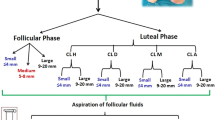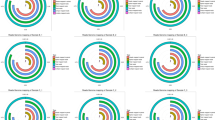Abstract
Purpose
To assess the age-associated changes in oocytes and granulosa cells derived from early antral follicles (EAFs).
Method
Gene expression analysis of granulosa cells of the EAFs using a genome analyzer (Illumina) and in vitro culture of oocyte-granulosa cell complexes (OGCs) of EAFs (400–700 μm in diameter) collected from ovaries of aged (>120 months) and young (<50 months) cows.
Results
Gene expression profiles in granulosa cells of EAFs of aged cows, which included changes in genes that encode chaperone proteins and antioxidants. In vivo development of EAFs, as determined by oocyte diameter of EAFs and AFs (3–6 mm in diameter), appeared to be impaired in aged cows and the OGCs of aged cows contained low GSH compared to younger counterparts. When the OGCs were cultured in a medium containing low estradiol (E2, 0.1 μg/mL), the ratio of antrum formation was higher for OGCs from aged animals than that from young animals, while higher abnormal fertilization rate and lower total cell number of the blastocysts were observed in the OGCs of aged cows compared with those of young cows. On the contrary, when the OGCs were cultured in a medium containing 10 μg/mL E2, the ratio of antrum formation and fertilization outcome was comparable between the two age groups, whereas the total cell number of the blastocysts was still low in the aged group.
Conclusion
Aging affects the gene expression profiles of the granulosa cells, and impairs in vitro developmental ability of OGCs collected from EAFs.
Similar content being viewed by others

References
Baerwald AR, Adams GP, Pierson RA. Characterization of ovarian follicular wave dynamics in women. Biol Reprod. 2003;69:1023–31.
Malhi PS, Adams GP, Singh J. Bovine model for the study of reproductive aging in women: follicular, luteal, and endocrine characteristics. Biol Reprod. 2005;73:45–53.
Malhi PS, Adams GP, Pierson RA, Singh J. Bovine model of reproductive aging: response to ovarian synchronization and superstimulation. Theriogenology. 2006;66:1257–66.
Janny L, Menezo YJ. Maternal age effect on early human embryonic development and blastocyst formation. Mol Reprod Dev. 1996;45:31–7.
Scholtes MC, Zeilmaker GH. Blastocyst transfer in day-5 embryo transfer depends primarily on the number of oocytes retrieved and not on age. Fertil Steril. 1998;69:78–83.
Pantos K, Athanasiou V, Stefanidis K, Stavrou D, Vaxevanoglou T, Chronopoulou M. Influence of advanced age on the blastocyst development rate and pregnancy rate in assisted reproductive technology. Fertil Steril. 1999;71:1144–6.
Shapiro BS, Richter KS, Harris DC, Daneshmand ST. Influence of patient age on the growth and transfer of blastocyst-stage embryos. Fertil Steril. 2002;77:700–5.
Malhi PS, Adams GP, Mapletoft RJ, Singh J. Oocyte developmental competence in a bovine model of reproductive aging. Reproduction. 2007;134:233–9.
Yamamoto T, Iwata H, Goto H, Shiratuki S, Tanaka H, Monji Y, et al. Effect of maternal age on the developmental competence and progression of nuclear maturation in bovine oocytes. Mol Reprod Dev. 2010;77:595–604.
Iwata H, Goto H, Tanaka H, Sakaguchi Y, Kimura K, Kuwayama T, et al. Effect of maternal age on mitochondrial DNA copy number, ATP content and IVF outcome of bovine oocytes. Reprod Fertil Dev. 2011;23:424–32.
Takeo S, Goto H, Kuwayama T, Monji Y, Iwata H. Effect of maternal age on the ratio of cleavage and mitochondrial DNA copy number in early developmental stage bovine embryos. J Reprod Dev. 2012;59:174–9.
Djahanbakhch O, Ezzati M, Zosmer A. Reproductive ageing in women. J Pathol. 2007;211:219–31.
Bancsi LF, Broekmans FJ, Eijkemans MJ, de Jong FH, Habbema JD, te Velde ER. Predictors of poor ovarian response in in vitro fertilization: a prospective study comparing basal markers of ovarian reserve. Fertil Steril. 2002;77:328–36.
Malhi PS, Adams GP, Mapletoft RJ, Singh J. Superovulatory response in a bovine model of reproductive aging. Anim Reprod Sci. 2008;109:100–9.
Xu J, Bernuci MP, Lawson MS, Yeoman RR, Fisher TE, Zelinski MB, et al. Survival, growth, and maturation of secondary follicles from prepubertal, young, and older adult rhesus monkeys during encapsulated three-dimensional culture: effects of gonadotropins and insulin. Reproduction. 2010;140:685–97.
Choi JK, Ahn JI, Park JH, Lim JM. Derivation of developmentally competent oocytes by in vitro culture of preantral follicles retrieved from aged mice. Fertil Steril. 2011;95:1487–9.
Orisaka M, Tajima K, Tsang BK, Kotsuji F. 2009. Oocyte-granulosa-theca cell interactions during preantral follicular development. J Ovarian Res. 2009;2:9.
Tatone C, Carbone MC, Falone S, Aimola P, Giardinelli A, Caserta D, et al. Age-dependent changes in the expression of superoxide dismutases and catalase are associated with ultrastructural modifications in human granulosa cells. Mol Hum Reprod. 2006;12:655–60.
Hurwitz JM, Jindal S, Greenseid K, Berger D, Brooks A, Santoro N, et al. Reproductive aging is associated with altered gene expression in human uteinizedgranulosa cells. Reprod Sci. 2010;17:56–67.
Ito M, Miyado K, Nakagawa K, Muraki M, Imai M, Yamakawa N, et al. Age-associated changes in the subcellular localization of phosphorylated p38 MAPK in human granulosa cells. Mol Hum Reprod. 2010;16:928–37.
Goto H, Iwata H, Takeo S, Nisinosono K, Murakami S, Monji Y, et al. Effect of bovine age on the proliferative activity, global DNA methylation, relative telomere length and telomerase activity of granulosa cells. Zygote. 2013;21:256–64.
Lim J, Luderer U. Oxidative damage increases and antioxidant gene expression decreases with aging in the mouse ovary. Biol Reprod. 2011;84:775–82.
Beg MA, Bergfelt DR, Kot K, Wiltbank MC, Ginther OJ. Follicular-fluid factors and granulosa-cell gene expression associated with follicle deviation in cattle. Biol Reprod. 2001;64:432–41.
Endo M, Kawahara-Miki R, Cao F, Kimura K, Kuwayama T, Monji Y, et al. Estradiol supports in vitro development of bovine early antral follicles. Reproduction. 2013;145:85–96.
Hirao Y, Itoh T, Shimizu M, Iga K, Aoyagi K, Kobayashi M, et al. In vitro growth and development of bovine oocyte-granulosa cell complexes on the flat substratum: effects of high polyvinylpyrrolidone concentration in culture medium. Biol Reprod. 2004;70:83–91.
Hirao Y. Conditions affecting growth and developmental competence of mammalian oocytes in vitro. Anim Sci J. 2011;82:187–97.
Takahashi Y, First NL. In vitro development of bovine one-cell embryos: Influence of glucose, lactate, pyruvate, amino acids and vitamins. Theriogenology. 1992;37:963–78.
Takeo S, Kawahara-Miki R, Goto H, Cao F, Kimura K, Monji Y, et al. Age-associated changes in gene expression and developmental competence of bovine oocytes, and a possible countermeasure against age-associated events. Mol Reprod Dev. 2013;80:508–21.
Mortazavi A, Williams BA, McCue K, Schaeffer L, Wold B. Mapping and quantifying mammalian transcriptomes by RNA-Seq. Nat Methods. 2008;5:621–8.
Tasaki H, Iwata H, Sato D, Monji Y, Kuwayama T. Estradiol has a major role in antrum formation of porcine preantral follicles cultured in vitro. Theriogenology. 2013;5:809–14.
Greenaway J, Gentry PA, Feige JJ, LaMarre J, Petrik JJ. Thrombospondin and vascular endothelial growth factor are cyclically expressed in an inverse pattern during bovine ovarian follicle development. Biol Reprod. 2005;72:1071–8.
Harlow CR, Bradshaw AC, Rae MT, Shearer KD, Hillier SG. Oestrogen formation and connective tissue growth factor expression in rat granulosa cells. J Endocrinol. 2007;192:41–52.
Assidi M, Dufort I, Ali A, Hamel M, Algriany O, Dielemann S, et al. Identification of potential markers of oocyte competence expressed in bovine cumulus cells matured with follicle-stimulating hormone and/or phorbol myristate acetate in vitro. Biol Reprod. 2008;79:209–22.
Rasmussen LS, Gisvold SE. New author guidelines. Acta Anaesthesiol Scand. 2008;52:594–5.
Chen AQ, Wang ZG, Xu ZR, Yu SD, Yang ZG. Analysis of gene expression in granulosa cells of ovine antral growing follicles using suppressive subtractive hybridization. Anim Reprod Sci. 2009;115:39–48.
Hayashi KG, Ushizawa K, Hosoe M, Takahashi T. Differential genome-wide gene expression profiling of bovine largest and second-largest follicles: identification of genes associated with growth of dominant follicles. Reprod Biol Endocrinol. 2010;5:8–11.
Mora JM, Fenwick MA, Castle L, Baithun M, Ryder TA, Mobberley M, et al. Characterization and significance of adhesion and junction-related proteins in mouse ovarian follicles. Biol Reprod. 2012;153:1–14.
Fargnoli J, Kunisada T, Fornace Jr AJ, Schneider EL, Holbrook NJ. Decreased expたさきssion of heat shock protein 70 mRNA and protein after heat treatment in cells of aged rats. Proc Natl Acad Sci U S A. 1990;87:846–50.
Pratsinis H, Tsagarakis S, Zervolea I, Giannakopoulos F, Stathakos D, Thalassinos N, Kletsas D. Chronic in vivo exposure to glucocorticoids prolongs cellular lifespan: the case of Cushing’s syndrome-patients’ fibroblasts. 2002;37:1237–45.
Gagliano N, Grizzi F, Annoni G. Mechanisms of aging and liver functions. Dig Dis. 2007;25:118–23.
Velazquez MM, Alfaro NS, Dupuy CR, Salvetti NR, Rey F, Ortega HH. Heat shock protein patterns in the bovine ovary and relation with cystic ovarian disease. Anim Reprod Sci. 2010;118:201–9.
Gola G, Reggiani L, Romanzi F, Beraudo ML. Principle data in the functional treatment of the antero-posterior and vertical dimensions of the arch. Parodontol Stomatol (Nuova). 1985;24:223–32.
Liu Z, Youngquist RS, Garverick HA, Antoniou E. Molecular mechanisms regulating bovine ovarian follicular selection. Mol Reprod Dev. 2009;76:351–66.
Pan X, Zhao J, Zhang WN, Li HY, Mu R, Zhou T, et al. Induction of SOX4 by DNA damage is critical for p53 stabilization and function. Proc Natl Acad Sci U S A. 2009;106:3788–93.
Qi M, Zhang J, Zeng W, Chen X. DNAJB1 stabilizes MDM2 and contributes to cancer cell proliferation in a p53-dependent manner. Biochim Biophys Acta. 1839;2014:62–9.
Valente P, Fassina G, Melchiori A, Masiello L, Cilli M, Vacca A, et al. TIMP-2 over-expression reduces invasion and angiogenesis and protects B16F10 melanoma cells from apoptosis. Int J Cancer. 1998;19(75):246–53.
Stetler-Stevenson WG, Seo DW. TIMP-2: an endogenous inhibitor of angiogenesis. Trends Mol Med. 2005;11:97–103.
Valeri C, Pappalardo S, De Felici M, Manna C. Correlation of oocyte morphometry parameters with woman’s age. J Assist Reprod Genet. 2011;28:545–52.
Kato S, Endoh H, Masuhiro Y, Kitamoto T, Uchiyama S, Sasaki H, et al. Activation of the estrogen receptor through phosphorylation by mitogen-activated protein kinase. Science. 1995;270:1491–4.
Tschugguel W, Dietrich W, Zhegu Z, Stonek F, Kolbus A, Huber JC. Differential regulation of proteasome-dependent estrogen receptor alpha and beta turnover in cultured human uterine artery endothelial cells. J Clin Endocrinol Metab. 2003;88:2281–7.
Pinzone JJ, Stevenson H, Strobl JS, Berg PE. Molecular and cellular determinants of estrogen receptor alpha expression. Mol Cell Biol. 2004;24:4605–12.
Soltysik K, Czekaj P. Membrane estrogen receptors - is it an alternative way of estrogen action? J Physiol Pharmacol. 2013;64:129–42.
Yan J, Suzuki J, Yu X, Kan FW, Qiao J, Chian RC. Cryo-survival, fertilization and early embryonic development of vitrified oocytes derived from mice of different reproductive age. J Assist Reprod Genet. 2010;27:605–11.
Acknowledgments
We thank Yuh Shiwa, Misaki Imai, Hikaru Wada, Chihiro Yamamoto, and Kazuma Tsunematsu for technical support. This study was supported by the Promotion and Mutual Aid Corporation for Private Schools of Japan and the Ministry of Education, Culture, Sports, Science, and Technology [Grants-in-Aid for Scientific Research (S0801025)] and Grant-in-Aid for Scientific Research C (KAKENHI, grant number: 25450400) from the Japan society for the Promotion of Science.
Author information
Authors and Affiliations
Corresponding author
Additional information
Capsule N Itami conducted culture experiment and wrote this paper and R Kawahara-Miki conducted gene expression analysis and wrote this paper. Their contributions are equal.
N Itami conducted culture experiments and R Kawahara-Miki conducted gene expression analysis and both authors contributed equally to this study.
Rights and permissions
About this article
Cite this article
Itami, N., Kawahara-Miki, R., Kawana, H. et al. Age-associated changes in bovine oocytes and granulosa cell complexes collected from early antral follicles. J Assist Reprod Genet 31, 1079–1088 (2014). https://doi.org/10.1007/s10815-014-0251-y
Received:
Accepted:
Published:
Issue Date:
DOI: https://doi.org/10.1007/s10815-014-0251-y



